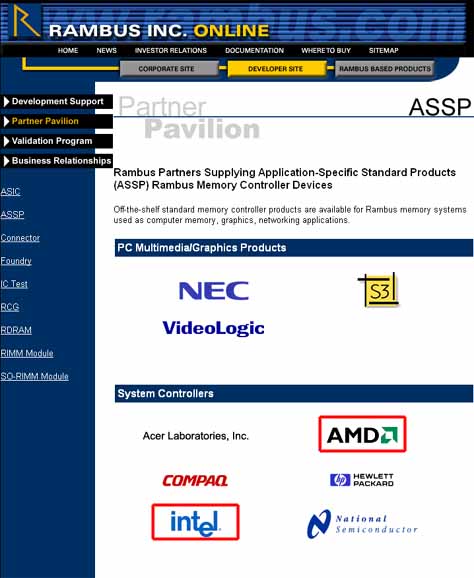Rambus DRAM: Uncovering Facts & Burying Rumors
by Anand Lal Shimpi on May 15, 2000 12:27 AM EST- Posted in
- Memory
So far we have yet to establish a relationship between Rambus and Intel, but it is time for that connection to be made.
First and foremost, Intel does not own Rambus. Rambus has been a publicly traded company since 1997 and has been around since 1990 as a privately held company. Intel's relationship with Rambus, although a very public one, is limited to one specific thing: Intel is a Rambus partner that has a license to produce Rambus memory controller devices.
Rambus has existed in the past. Long before the release or even the announcement of Intel's 820 chipset, Rambus had products that made their way onto graphics adapters and even console gaming systems alike.
As it stands, there are three generations of RDRAM, the first incarnation being Base RDRAM, the following being Concurrent RDRAM and the current type, Direct RDRAM. If you take the first letter from all three of these RDRAM generations, you get the three generations of Rambus technology, B, C, and D – how cute. So while Direct RDRAM just recently made its introduction (it features a wider bus and higher operating frequency than previous versions of RDRAM), the technology has been around for quite some time.
As we mentioned before, the high speed Rambus interface must be present both on the individual Rambus chips themselves and on the memory controller; in this particular case, on the chipset. Intel's partnership with Rambus is necessary in order to be able to license the technology required to include the Rambus memory interface in their i820 chipset and upcoming Tehama chipset. While it is obvious that Intel doesn't have to pay as much for the license as some of the other partners since, according to Rambus, they have a "special" relationship with Intel, other than that there is no real relationship between Rambus and Intel. The "special" relationship comes into play partially because Intel has claimed the equivalent of undying support for Rambus and RDRAM for their current and future products; if you were in Rambus' position, you would do the same thing to the one company that has helped you so much in the past.
Who are the other "partners" that have a license to use the Rambus interface in their chipset designs?
Well, other than Intel there is Compaq, Hewlett Packard, National Semiconductor, Acer Laboratories, Inc. (ALi) and Advanced Micro Devices otherwise known to us as the underdog just about everyone has been rooting for, AMD.

As the current industry leader, Intel is taking a risk in supporting RDRAM. They are betting on the fact that there is a clear need for a higher bandwidth memory solution and that RDRAM seems to be that very solution. If it turns out that RDRAM is the solution we've all been waiting for, then don't be surprised if you see AMD supporting RDRAM shortly thereafter, but at the same time, since Intel is the one putting themselves on the line here, if RDRAM isn't all that it's cracked up to be, AMD can just sit back and say "we told you so" without losing face.










1 Comments
View All Comments
dylan522p - Wednesday, December 11, 2013 - link
Wow I wish I read this all those years ago.